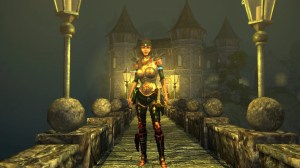Everybody knows the difference between the person at the party who wants to be cool and the one that simply is. It’s confidence. It’s style. It’s the hidden layers of history that make them who they are. Then beyond all of that there’s something else, a special, undefinable element that makes something cool.
Videos by ComicBook.com
Lots of comics want to be cool; Motor Crush just is.
When the creative team of Brendan Fletcher, Cameron Stewart, and Babs Tarr made their debut at DC Comics in Batgirl #35, it was clear they had the confidence and style down. Their layouts were slick, fast-paced, and loaded with tricks that showed a cool aplomb in comics storytelling. Each page could be dissected for the simple “how” of its telling. These were storytellers who wanted to tell their story and do it better than any of their peers.
That all remains the same in Motor Crush #1. Whether it’s a race team standing around the bike and swapping stories or Domino, the series’ protagonist, firing down a street in an illegal race swinging a bat at her opponents, this comic is packed with energy. In the quiet moments, it’s the quick glance, half-smile, or tilt of the head that manage to give more energy than they have any right to. In the loud moments, and there are plenty, well, in the loud moments, it couldn’t be any more obvious.
Professional motorcycle racers thunder through the streets of Nova Honda in Motor Crush. It’s a city perfect for racing in a world consumed by the sport. Small cameras follow popular racers about providing interviews and stats on the spot. They combine modern social media immediacy with an obsession for pop culture. The culture of racing itself is every bit as fast as the engines that send these men and women through the streets. It’s dangerous, tough, and choices occur so quickly that it’s difficult to recognize the bad ones until you’re dead. Both on and off the track, Motor Crush delivers its thrills.

The race sequences in Motor Crush #1 display the same quality of layouts that were so widely praised in this team’s Batgirl run. That same team opts to provide a single credit for all three names as creators, rather than distinguish roles between layouts, scripts, pencils, and other elements. It’s a choice that insinuates a highly collaborative environment, and one that makes sense given their strong visual grounding. These creators know how to make rev a page’s metaphorical engine and do so repeatedly here.
Inset panels and stilted diagonals quickly stack and build energy. There’s no wasted space as each new moment adds information and either creates a setup or payoff for some part of a race or chase. When a group of six underground racers plow through the night air of Nova Honda, it’s possible to trace each of their stories. They may begin and end quickly, but you can perceive their personalities, their style, and why they lose (or win, for just one). Not only is the entirety of the race there on the page, but it happens in a fashion that is genuinely exciting. Colors and speed lines make this story hum and each new change to the action comes so quickly that it’s impossible to stop flipping pages. This is how you make speed matter in comics, by making it immediate.
There’s that element of history in each of these pages as well. Motor Crush #1 is clearly Domino’s story. It’s her career, her bike, her team, and her aspirations that drive the plot. Yet the people and city around her do not exist in service to her. Even her doting father whose dearest wishes are clearly to see his daughter succeed has a history and life all his own. His peg leg sits in panels, suggesting a terrific tragedy and career ended too soon, but is never mentioned. His shop and words are all layered with meaning that doesn’t need to become overt in order to carry weight.

Just consider the street racers. In a quick profile and with brilliantly distinguished designs, they all become characters, as cartoonish as they may seem. Even Hannibal Holocaust, an insane cross between the clown bikers of Akira and Mr. McGibblets of The League, has a personality and drive that shines through his cold, plastic eyes and hammer swinging. If none of these racers were to appear again, the story would still be richer for them having simply appeared.
The detail in both character design and the city itself (carefully consider the signage) is enough, but Motor Crush #1 receives a significant boost from the design work of Tom Muller, as well. His captions don’t just relate knowledge, they construct a culture and tone that informs everything else. Logos and colors are all well considered and create the sense of a media conglomerate who has carefully crafted these messages and their form. Entire pages are told only with these captions, filling readers in with overt exposition that never reads like overt exposition. Instead you are tracing the logic of a digital design and infographics, seemingly immersed in an interactive interface that exists as a printed page.
Finally, there’s that last element, the undefinable one. It’s something that comes with the lightly traced palm trees behind Domino’s head when she first removes her helmet. It’s a feeling and a look. It’s that moment when you look at something on a comics page and just think, “Damn.” That’s all over Motor Crush #1. There’s one moment in particular lit by (quite literally) explosive pinks. It’ll make you recoil in your seat and utter a noise you didn’t expect yourself to make.
That’s when you can’t dispute that this comic is really, really cool.
And the great thing is that sort of reaction doesn’t happen just once in the debut of Motor Crush. Again and again I found myself twisting on the sofa as the story shot along, pistons firing and seemingly never stopping. It moves so quickly, you’ll think you’re reading a complete collection by the time you reach “To Be Continued”. But the reality is that this is a story that’s well told. It’s dense, but fast, giving you everything you could hope to be paying for. Wherever Domino’s story is going, you can be certain it’s going to be a wild ride.
And you can be damn certain all of the cool kids will be reading it.
Grade: A-








